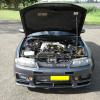Car Down On Power Over Entire Rev Range, Causes?
Announcements
-
Similar Content
-
Latest Posts
-
Except all that twisting force that is breaking a cast piece, appears to be going through 4 bolts in the picture Johnny posted of the BryPar one...
-
The smart approach is to use the gearbox loom from the manual car. Makes it a lot easier - just plugs into the switches on the box and plugs into the main loom up near the fusebox. Then you only need to deal with bypassing the inhibit switch. The other approach requires you to use the wiring diagram to identify those wires by colour and location, perhaps even indulging in a little multimeter action to trace them end to end to make sure, and then.... you will have the answers you need. The R34 wiring diagram is available on-line (no, I do not have a link to it myself - I would have to do a search if I wasn't able to go to the copy I have at home).
-
Hi, i’m converted my r34 4dr auto to manual but need help with gearbox wiring. There are bunch of wires no idea which one for speedo drive, neutral, reverse can anyone help me. IMG_6860.mov
-
By Rb25neos15 · Posted
@TurboTapin hey man thank you for all the info! I am about to order my cd00a today for a rb25 neo s15 build I am currently trying to get the ball rolling again on 😁 what is wrong with the Collin’s adapter? Is the bellhousing machining 15mm because that’s how thick the Collin’s adapter is or is that universal across any I decide to go with? Also do you recommend any adapter in particular? Thanks man 😃
-





Recommended Posts
Create an account or sign in to comment
You need to be a member in order to leave a comment
Create an account
Sign up for a new account in our community. It's easy!
Register a new accountSign in
Already have an account? Sign in here.
Sign In Now